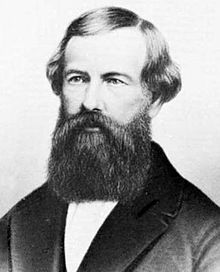Elisha Otis
This article has multiple issues. Please help improve it or discuss these issues on the talk page. (Learn how and when to remove these messages)
|
Elisha Graves Otis | |
|---|---|
 Elisha Graves Otis | |
| Born | August 3, 1811 Montpelier, Vermont, United States |
| Died | April 8, 1861 (aged 49) Yonkers, New York, United States |
| Nationality | American |
| Occupation | Engineer |
| Known for | Founder of the Otis Elevator Company |
| Spouse(s) | Susan Houghton, Elizabeth Otis |
| Children | Charles Rollin Otis, Norton Prentice Otis |
| Engineering career | |
| Projects | Elevators |
Elisha Graves Otis (August 3, 1811 – April 8, 1861) was an American industrialist and founder of the Otis Elevator Company.[1] In 1853, he invented a safety device that prevents elevators from falling if the hoisting cable fails.[2][3] On March 23, 1857, he installed the first safety elevator for passenger service in the store of E.V. Haughwout & Co. in New York City.[4]
Biography
[edit]
Otis was born in Halifax, Vermont, to Stephen Otis and Phoebe Glynn.[2][5] He moved away from home at the age of 19, eventually settling in Troy, New York, where he lived for five years employed as a wagon driver. In 1834, he married Susan A. Houghton. They had two children, Charles and Norton. Later that year, Otis suffered a terrible case of pneumonia which nearly killed him, but he earned enough money to move his wife and three-year-old son to the Vermont Hills on the Green River. He designed and built his own gristmill, but did not earn enough money from it, so he converted it into a sawmill, yet still did not attract customers. Now having a second son, he started building wagons and carriages, at which he was fairly skilled. His wife later died, leaving Otis with two sons, one age 8 and the other in infancy.


In 1845 he moved to Albany, New York, where he worked as a master mechanic in a bedstead factory. During this period he invented a railway safety brake. By 1852 he had moved to Yonkers, New York to work at the Maize & Burns bedstead factory installing machinery.[5] The factory needed a hoist to lift heavy equipment to the upper floor, but this posed serious safety issues. In response, Otis invented the safety elevator, which automatically comes to a halt if the hoisting rope breaks. The following year he left the factory and started his own company, the Otis Elevator Company.[4] After giving a public demonstration of his new invention at the New York Crystal Palace in 1854, demand for the safety elevator began to rise.[4] He installed the first safety elevator for passenger service at the E. V. Haughwout Building in New York City in 1857.[6][2][5]
In his spare time, he designed and experimented with his old designs of bread-baking ovens and train brakes, and patented a steam plow in 1857, a rotary oven in 1858, and, with Charles, the oscillating steam engine in 1860. The plough was not commercially successful.[7]
Otis contracted diphtheria and died on April 8, 1861, aged 49.[2] He was buried in Oakland Cemetery in Yonkers, New York.
Legacy
[edit]An Otis Elevator Company worker coined the term "escalator" to refer to continuous-loop moving staircases that could either ascend or descend. The company was acquired by United Technologies in 1976. In April 2020, Otis Elevators Company was spun off from United technology to be an independent elevator company.[5]
The WWII-era U.S. Liberty ship SS Elisha Graves Otis was named for him.[8]
References
[edit]- ^ Otis Elevator Company
- ^ a b c d "Elisha Graves Otis". Invent Now. Retrieved March 3, 2024.
- ^ Paumgarten, Nick (April 21, 2008). "Up and then Down". The New Yorker.
- ^ a b c "Elisha Otis". Britannica. July 30, 2024. Retrieved September 23, 2024.
{{cite web}}: CS1 maint: url-status (link) - ^ a b c d "Elisha Otis". PBS. September 7, 2024. Retrieved September 7, 2024.
{{cite web}}: CS1 maint: url-status (link) - ^ "Elisha Otis". Encyclopædia Britannica. Retrieved December 18, 2007.
- ^ Burton, Anthony (2000). Traction Engines Two Centuries of Steam Power. Silverdale Books. p. 38. ISBN 1856055337.
- ^ "Elisha Graves Otis". U.S. Department of Transportation. Retrieved August 28, 2023.
